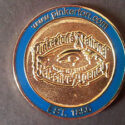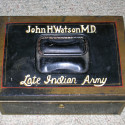A Scion Society of The Baker Street Irregulars
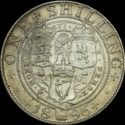
In for a Penny, In for a Pound – British Money as Holmes Knew It
“I’d like two shillin’ better”
– The Sign of the Four (SIGN)
Some Sherlockians are puzzled by references to money in the Sherlock Holmes adventures – “a fifty-guinea watch” in The Sign of Four, a pipe that cost “seven-and sixpence” in “The Yellow Face.”
The British monetary system was undoubtedly complicated. A pound was divided into 20 shillings, a shilling into 12 pennies, or pence.
But the working classes, and even many middle-class folk, had little contact with pounds. Ordinary Victorians drew their wages and salaries, paid their rent, bought their groceries – in fact lived their lives – in shillings and pence.
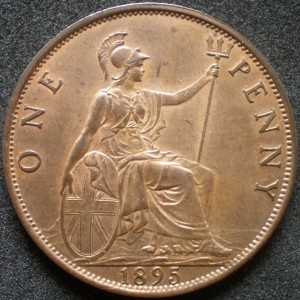
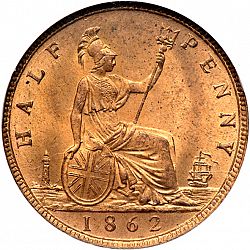
A penny had real buying power, and two coins of even smaller value were in daily use: the halfpenny, pronounced hayp’ney, and the farthing, worth a fourth of a penny. (Farthing was a corruption of “fourthing.”)
There are many references to these small coins in the Canon. In The Valley of Fear Holmes bought a pamphlet about Birlstone Manor for “the modest sum of a penny.” “You shall not have a farthing from me!” Alexander Holder shouted at his wayward son Arthur in “The Beryl Coronet.” And the pockets of the beggar Hugh Boone, in “The Man with the Twisted Lip,” were “stuffed with pennies and halfpennies.”
These coins were originally struck in copper, and collectively were known as coppers. After 1860 they were made of bronze, which held up better, but people still called them coppers. In “A Scandal in Bohemia,” Dr. Watson describes a man dashing to open Irene Adler’s carriage door “in the hope of earning a copper.”
Using coppers required a special vocabulary. The sum of 2½ pence was called twopence halfpenny (pronounced tuppence hayp’ney), 2¼ pence was tuppence farthing, and 1½ pence was called, oddly, three haypence. If a woman wanted to buy a halfpenny’s worth of tea she would ask for “a hayp’orth of tea.”
Silver coins began with the threepenny piece, commonly called the thruppenny bit. Next came the sixpence and the shilling. The sixpence was a small coin, about the size of a dime. The shilling, as mentioned above, was worth 12 pence, and there were 20 in a pound.
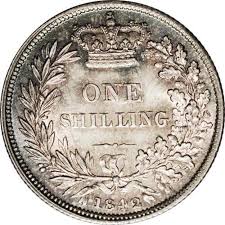
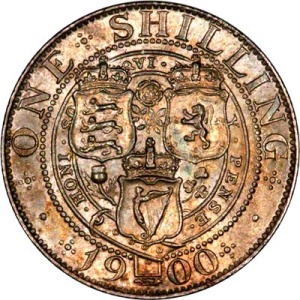
The shilling is by far the most frequently mentioned coin in the Canon. In A Study in Scarlet and The Sign of the Four, Holmes gave his street kids, the Baker Street Irregulars, a shilling a day apiece. (That was remarkably good pay; some skilled laborers didn’t make that much. Of course the boys only got it when they were on the job for Holmes.)
“Shillings have not been so plentiful with me as they once were,” confessed Henry Baker in “The Blue Carbuncle.” Mary Sutherland, in “A Case of Identity,” reported that her missing fiancé Hosmer Angel “was very independent about money, and never would look at a shilling of mine.”
In “The Red Circle” a landlady named Mrs. Warren told Holmes she charged fifty shillings a week for a two-room suite – in other words, two pounds, ten shillings. Sums less than four or five pounds were often expressed in shillings.
The sixpence and the shilling had nicknames: tanner and bob, respectively. When Holmes summoned the Baker Street Irregulars in The Sign of Four they traveled to 221B by Underground. Wiggins, their leader, reported, “Got your message, sir, and brought ‘em on sharp. Three bob and a tanner for tickets.”
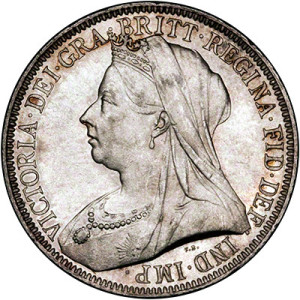
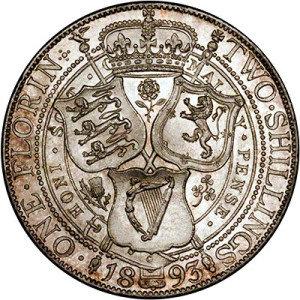
The florin was a silver coin worth two shillings. For some reason British people rarely used the word, preferring to say “two shillings.” The florin appears by implication in The Sign of Four when Holmes tries to get information from Mrs. Smith by jollying up her little son:
“Now, Jack, is there anything you would like?”
The youth pondered for a moment.
“I’d like a shillin’,” said he.
“Nothing you would like better?”
“I’d like two shillin’ better,” the prodigy answered, after some thought.
“Here you are, then! Catch!”
The next higher silver coin was the half-crown, worth two shillings sixpence – two and six in everyday speech. Dr. Watson, in “A Scandal in Bohemia,” commented that the King of Bohemia’s notepaper “could not be bought for less than half a crown a packet.”
The crown was worth five shillings. There is no mention of it in the Canon, which is not surprising because people avoided it. It was big and heavy, and not convenient to carry in the pocket.
Americans sometimes refer to coins as silver. The term was also used in Britain. We recall this conversation in “The Dying Detective,” in which Holmes was pretending to be delirious:
“Now, Watson,” said he, “have you any change in your pocket?”
“Yes,”
“Any silver?”
“A good deal.”
“How many half crowns?”
“I have five.”
“All, too few! Too few! How very unfortunate, Watson! However, such as they are you can put them in your watch-pocket. And the rest of your money in your left trouser-pocket. Thank you. It will balance you so much better like that.”
Dividing the shilling into twelve pence made for complicated transactions. People had to become adept at reckoning in their heads. If a woman bought an article that cost four shillings fivepence and gave the shop assistant a coin worth ten shillings, she would mentally calculate how much she was owed in change: five shillings sevenpence.
On paper, the price of her purchase would be expressed as 4s. 5d. (The “d,” symbol for the penny, was borrowed from a Roman coin called the denarius.) More simply, the sum could be called four-and-fivepence and written 4/5.
In Holmes’s time some coins were made of gold. (Britain continued to mint them until the country went off the gold standard during the Great Depression of 1929.) The basic gold piece was the sovereign, worth one pound or twenty shillings.
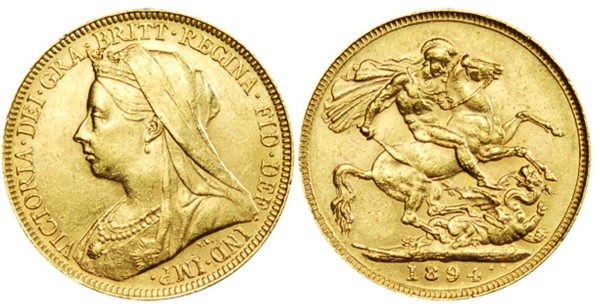
We read a great deal about sovereigns in the Canon. In “The Blue Carbuncle” Holmes made a bet of a sovereign with a poultry dealer called Breckinridge. While disguised as a drunken groom in “A Scandal in Bohemia” he received a sovereign as a tip from Irene Adler. He offered the innkeeper Reuben Hayes a sovereign for the use of a bicycle in “The Priory School.”
The word sovereign referred to the coin itself. “Three pounds” could mean that amount of money in any form – in notes, in coin, or written in an invoice. “Three sovereigns” specifically meant three gold coins, each worth one pound.
There was also a half-sovereign coin, worth ten shillings. Sherlock Holmes, seeking information, gave one of them to Police Constable Ranee in A Study in Scarlet and another to John Clayton, the cab driver in The Hound of the Baskervilles.
The slang term for the pound, quid, is still heard today. It occurs just once in the Canon. In “The Mazarin Stone,” Holmes offers to let Count Sylvius and his henchman Sam Merton go free if they will give up the jewel they have stolen. Merton replies, “What! Give it up? Give up a hundred thousand quid?” (The word is both singular and plural: “Lend me a quid” or “Lend me ten quid.”)
There was no one-pound note in Holmes’s day, but five- and ten-pound notes were common enough to have nicknames. “As to money,” the miserly Lord St. James told Holmes in “The Missing Three-Quarter,” “well, so far as a fiver, or even a tenner, goes, you can always look to me.”
Paper money was issued in ascending values up to £1,000. The notes were issued not by the British Treasury but by the Bank of England. A few other banks also had the authority to issue paper money.
There are several mentions of bank notes in the Canon. Elsie Cubitt, in “The Dancing Men,” tried to bribe Abe Slaney to leave her alone by offering him £1,000 in £50-pound notes. The anonymous borrower in “The Beryl Coronet” pawned the coronet for £50,000, which was paid to him in thousand-pound notes.
In the Victorian era the pound was worth about $5 in American money of the time, with the shilling worth about a quarter. To get an idea of the value in today’s money of any Victorian sum, British or American, we have to take inflation into account, multiplying by ten or even twenty.

The guinea is a fun- example of English eccentricity, and tells us something about the Victorian class system. The pound, as we have said, contained 20 shillings. The guinea contained 21 shillings.
Coins called guineas and half guineas were first struck during the reign of Charles II. They got their names from the fact that the gold they were made of came from the Guinea Coast of Africa. Over the next 150 years the value of the guinea was officially changed several times.
In 1816 the British Treasury undertook a general monetary reform. The Royal Mint had stopped producing guineas and half-guineas three years earlier, but the coins were still in circulation. The Treasury fixed the value of the guinea at the irregular figure of 21 shillings. Research has not turned up a reason for this, but a likely guess is that the value was based on the amount of gold in the coin.
Guinea and half-guinea coins remained in circulation for a long time. There must have been a few still around in Holmes’s day, seventy years later. Godfrey Norton, on his way to marry Irene Adler in “A Scandal in Bohemia,” told the cabman, “Drive like the devil… Half a guinea if you do it in twenty minutes!”
Mostly, however, the guinea existed on paper. Professional men – lawyers, doctors, engineers – stated their fees in guineas. In “The Missing Three-Quarter” Dr. Leslie Armstrong charged Godfrey Staunton thirteen guineas for his services (it would have been written “13 gn.” in the bill). In “The Engineer’s Thumb,” Victor Hatherley was offered fifty guineas to inspect a hydraulic press. This would have been paid to him as fifty pounds and fifty shillings, or £52 10s. (In the event, of course, Hatherley never got his money.)
Luxury items were also priced in guineas. We remember the “fifty-guinea watch” that Dr. Watson inherited in The Sign of Four. In “A Scandal in Bohemia” Holmes looked out of the window and observed, “A nice little brougham and a pair of beauties. A hundred and fifty guineas apiece. There’s money in this case, Watson, if there is nothing else.”
Exactly! Money was the unspoken force behind the guinea. Guineas conferred status on the persons who charged them and the persons who paid them. Fashionable shops quoted prices in guineas because their customers could afford to pay an extra shilling to the pound. The customers paid in guineas to affirm their position in society.
In The Hound of the Baskervilles a mysterious man in a cab shadowed Holmes and Watson as they walked along Regent Street. The cabman, John Clayton, later told Holmes that the man “offered me two guineas if I would do exactly what he wanted all day and ask no questions.” Two pounds would have been excellent pay, so why two guineas? An extra two shillings, of course, but more importantly, the mysterious man was flattering Clayton by conferring status on him.
Holmes did the same thing with his Baker Street Irregulars in The Sign of Four, when he sent them searching for the launch Aurora along the River Thames, “The old scale of pay [a shilling a day]”, he told them, “and a guinea to the boy who finds the boat.”
Using British money was undeniably a complicated business, not only for accountants and shopkeepers but for anyone who bought anything – in other words, the entire population of Great Britain. In 1971, after years of debate, the British government adopted a decimal system with 100 “new pence” to the pound. Since then several generations of British people have grown up who know as little of British people have grown up who know as little about half-crowns and farthings as Americans do. So if you’re confused by the references to money in the Canon, take comfort – so are the Brits.
This post was originally published in the 2017 edition of Irene’s Cabinet, published by Watson’s Tin Box.
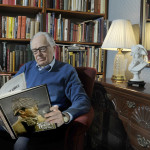 William Hyder, a native of New York, joined the Six Napoleons of Baltimore in 1962 and would later serve as the group’s Harker for over 20 years, in addition to terms as Commissionaire and Gasogene. Invested as “A Most Valued Institution” in the Baker Street Irregulars in 1997, Hyder is also a Master Copper-Beech-Smith of the Sons of the Copper Beeches and a member of the Sherlock Holmes Society of London. Hyder is a prolific author, after spending 35 years with The Baltimore Sun, with articles appearing in The Baker Street Journal and Baker Street Miscellaneous, among others. The editor of BSI’s Sherlockian Saturdays at the Pratt and The Napoleon Bust Business Again, Hyder is also the author of From Baltimore to Baker Street: Thirteen Sherlockian Studies.
William Hyder, a native of New York, joined the Six Napoleons of Baltimore in 1962 and would later serve as the group’s Harker for over 20 years, in addition to terms as Commissionaire and Gasogene. Invested as “A Most Valued Institution” in the Baker Street Irregulars in 1997, Hyder is also a Master Copper-Beech-Smith of the Sons of the Copper Beeches and a member of the Sherlock Holmes Society of London. Hyder is a prolific author, after spending 35 years with The Baltimore Sun, with articles appearing in The Baker Street Journal and Baker Street Miscellaneous, among others. The editor of BSI’s Sherlockian Saturdays at the Pratt and The Napoleon Bust Business Again, Hyder is also the author of From Baltimore to Baker Street: Thirteen Sherlockian Studies.

